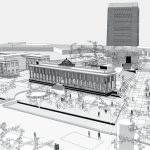-
Academy for Experimental Music
July 2013

STUDENT: Niroshini Goonetilake | INSTITUTION: City School of Architecture
Experimental music fundamentally refers to “sound” itself, regardless of whether it emanates from a standard instrument or is the sound of one’s own heartbeat. Fusion music, on the other hand is the integration of music of different cultures and periods of time.
The academy will be a place where every space has its own character and magic, engendering an ambiance that inspires the music enthusiast to create and become part of a unique and extraordinary world of music.
Located in Colombo 2 on a 1.8 ha area facing Sir James Peiris Mawatha, the site is bordered by the State Engineering Corporation, Muttiah Grounds, and the Gangaramaya Temple. It was chosen based on the availability of diverse “sounds” in the immediate context. The setting’s cultural infrastructure, its wide spectrum of users and the incessant flow of pedestrian traffic in the vicinity of the site contribute to the enrichment of the project. Experimental music is about “sound” in all its manifestations. Since one could, to a great extent, ignore the spatial requirements needed for the reproduction of conventional music, the metaphor of “frozen sound” was used as the concept for the design. The structure and its spaces represent sound, fusion and experimentation. Thus, every aspect of the design, in the form of materials, form and space, was considered as having the potential to generate “sound.”
The design consists of four sections, namely the theatre, the academy, “warehouse” and the residential quarters.
Each part of the building consists of an “acoustic node,” where innovative use of materials modulates sounds within that space. Zoning was achieved by carefully considering the intensity of sound in the various parts of the site. The areas with the highest level of decibels were set aside for public use while the converse was the case in regard to the quieter areas of the scheme. Architecturally, therefore, the “louder” spaces would be larger, with the essentially quieter spaces diminishing in size.
One enters the building from a centrally located, elevated, cavernous public lobby with its specialized building materials and countless exhibits of experimental instruments – and to the sounds of the work of world renowned experimental musicians. A 400-seat auditorium is located above this space, its lobby overlooking the CBD and Beira Lake, foregrounded by the picturesque Seemamalakaya of the Gangaramaya Temple. This scenic location makes this theatre, arguably, one of the most elegant in the city. The academy itself with its lecture rooms is uniquely located to create a special “mood” for each class and practice space. These mood catalysts are views afforded by the lake, the CBD, zen gardens, the temple, the presence of traffic, water sound rooms and the hollow steel tubes fixed onto walls. The roofs are also terraced to function as practice spaces. There is a materiality peculiar to each space which modulates the sounds produced in that particular space. Thus, the experimental musician could draw his inspiration from the natural sounds of the immediate context of each individual space.
There is no such thing as an empty space or an empty time. There is always something to see, something to hear. In fact, try as we may to make a silence, we cannot.”
– John Cage –
The “warehouse,” located at one end of the site and opening out to large open spaces where crowds could gather to watch both open air and indoor performances, provides a more informal setting for such activity. It is essentially a rhomboidal, multiple height void, the mezzanines of which are connected by a series of bridges with light streaming in from openings strategically placed on the building envelope. This is the ultimate space for experimentation, where the space itself would become part of the music. Distinctions of performer, instrument, observer, ambiance and space would dissolve into a grand unifying experience of raw pulsating sound within this space.
Thus the design is one that listens to its context, listens to its site and its inhabitants in order to become a metaphor for experimental music itself.
















